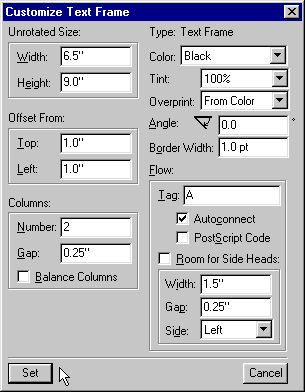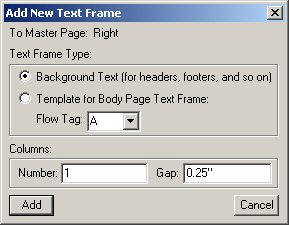FrameMaker 7.0 Tutorial: Master Pages
About Master Pages
FrameMaker documents are made up of three types of pages: body pages, reference pages, and master pages. When you create a new document, these pages are automatically created.
Reference pages and master pages contain reference material and page layout information that is applied to the body pages. You can use master pages to design custom page layouts for different elements within your document, such as title pages, indexes, and tables of contents.
Creating a Master Page
This section guides you through the steps required to create a master page. In this exercise, you create a custom master page for a glossary.
To create a master page:
- Open FrameMaker, and select File > New > Document.
- From the New dialog box, click Portrait.
- Select File > Save As.
- In the File name box, type glossary.fm and click Save.
Note: If you are working in the TCM computer lab, save the file to your lab account. If you do not have a lab account, please contact your instructor. - Press and hold the Enter key to create two to three pages filled with carriage returns.
- Select View > Master Pages.
The master page appears. (Notice that a master page for only the right page appears.) This master page contains a header frame, a main text frame, and a footer frame.
- Select Format > Page Layout > New Master Page to create a new master page.
The Add Master Page dialog box appears.

- In the Add Master Page dialog box, type Glossary, and click Add.
Notice the status bar shows the name of the master page that is currently displayed.

Since a glossary typically includes two columns, you must change the main text frame to incorporate two columns.
- Press and hold the Ctrl key, and then click within the main text frame to select it.
- Select Format > Customize Layout > Customize Text Frame.
The Customize Text Frame dialog box appears.

- In the Columns area, type 2 in the Number box.
- Click Set.
The main text frame for the glossary master page now has two columns.
Creating Headers and Footers
This section describes the procedures necessary to create headers and footers. For this tutorial, you create a new header frame and then modify the existing footer.
To create a new header frame:
- Press and hold the Ctrl key, and then click inside the existing header frame.
- Press Delete to remove the existing header frame.
- Select Graphics > Tools (or click
 located on the right side of the FrameMaker document window).
located on the right side of the FrameMaker document window).
- From the Tools Palette, click
 (Text Frame).
(Text Frame).
- Draw a new header frame approximately 7 inches long by 1/2 inches high. (As you draw, the lower left corner of the status bar shows the dimensions of the frame.)
Once you finish drawing the header frame, the Add New Text Frame dialog box appears.

- If it is not already selected, select the Background Text option.
- Click Add to insert the header frame.
- Click outside the header frame to deselect the frame.
- Click within the header frame, and type Glossary.
- Apply paragraph formats as desired.
To modify the existing footer:
- Press and hold the Ctrl key, and then click inside the footer frame.
- Select Graphics > Scale.
The Scale dialog box appears.

- In the Height box, type 0.4″, and then click Scale.
- Click outside the footer frame to deselect the frame.
- Click within the footer frame, and select Special > Variable.
The Variable dialog box appears.

- In the Variable dialog box, click Current Page #, and click Insert.
The # symbol is inserted within the footer; this symbol is a system variable that represents the current page number. You can view the page number by selecting View > Body Pages.
Adding Graphics
This section describes how to add graphics to a master page.
Before you begin, download the graphic file:
- Select the following link: tip.gif
Note: Earlier versions of Netscape may attempt to display this file directly. To force Netscape to download this file, right-click the link above, and select Save Link Target As. - Select the directory in which to save the file, and click Save.
- Click Save.
| Note: If you are working in the TCM computer lab, save the file to your lab account. If you do not have a lab account, please contact your instructor. |
To add the graphic to your master page:
- Scroll to the top of the glossary master page.
- From the Tools Palette, click
 (Place a Graphic Frame).
(Place a Graphic Frame).
- Draw a small graphic frame in the upper left corner of the master page (outside the main text frame).
- Select the graphic frame, and then select File > Import > File.
- Locate the directory in which you saved the graphic file, select tip.gif, and click Import.
The Imported Graphic Scaling dialog box appears.

- Select the Custom dpi option, and type 96 in the text box.
- Click Set.
The graphic is inserted into the master page.
Applying Master Pages
By default, Framemaker pages use the right master page; therefore, after you create a custom master page, you must apply it to your body page.
To apply a master page to a body page:
- Select View > Body Pages to view body pages.
- Select Format > Page Layout > Master Page Usage.
The Master Page Usage dialog box appears.

- From the Master Page dialog box, select Glossary from the Custom pull-down menu. (In the Apply To area of the Master Page Usage dialog box, you can specify the document pages that will use the glossary master page. For now, apply to Current Page.)
- Click Apply.
The current body page now uses Glossary as its master page. ( Notice you cannot select or edit the text or graphics that you added to the master page. You must modify this information from the master page.)
In this tutorial, you learned how to create a master page and add columns, headers and footers, and graphics to the master page. Experiment by creating your own master pages and applying them to the remaining body pages within your document.


Comments